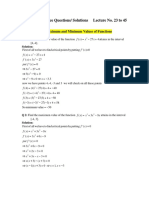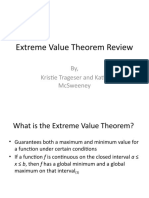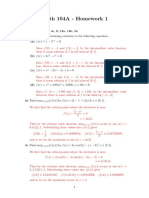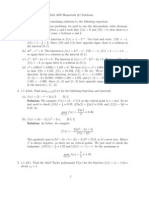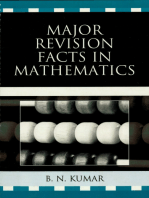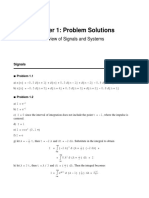Solution To Practice Exercise For Lecture 23
Solution To Practice Exercise For Lecture 23
Uploaded by
Raja Tausif AhmedCopyright:
Available Formats
Solution To Practice Exercise For Lecture 23
Solution To Practice Exercise For Lecture 23
Uploaded by
Raja Tausif AhmedCopyright
Available Formats
Share this document
Did you find this document useful?
Is this content inappropriate?
Copyright:
Available Formats
Solution To Practice Exercise For Lecture 23
Solution To Practice Exercise For Lecture 23
Uploaded by
Raja Tausif AhmedCopyright:
Available Formats
Solution To Practice Exercise For Lecture 23
Q1. Find the minimum value of the function f ( x ) x 3 27 x 4 attains in the interval
[4,-4].
Solution.
First of all we have to find critical points by putting f '( x )=0
f ( x ) x 3 27 x 4
f '( x ) 3x 2 27
put f '( x ) 0
3x 2 27 0
3( x 2 9) 0
x 2 9 0 x 3, 3
now we have points 4,-4, -3 and 3 we will check on all these points
f (4) (4)3 27(4) 4 40
f ( 2) ( 4)3 27( 4) 4 48
f (3) (3)3 27(3) 4 50
f ( 3) ( 3)3 27( 3) 4 58
So minimum value 50
Q2. Find the maximum value of the function f ( x ) x 3 3x 2 9 x attains in the
interval [-4, 3].
Solution.
First of all we have tofind critical points by putting f '( x) 0
f ( x ) x 3 3x 2 9 x
f '( x) 3x 2 6 x 9
put f '( x) 0
3x 2 6 x 9 0
x2 2x 3 0
x 2 3x x 3 0
x( x 3) ( x 3) 0
( x 1)( x 3) 0 x 1, x 3
now we have points 1,-3, 3 and -4 we will check on all these points
f (1) (1)3 3(1) 2 9(1) 5
f ( 3) ( 3)3 3( 3)2 9( 3) 27
f (3) (3)3 3(3) 2 9(3) 27
f ( 4) ( 4)3 3( 4)2 9( 4) 20
Hence maximum value f ( 3) f (3) 27
Q3. Find the absolute maximum and absolute minimum values of the function
f ( x ) 4 x 2 on interval 3 x 1 .
Solution.
First we will find critical points:
put f / ( x ) 0
2 x 0
x0
Now we find value of f ( x ) at critical point and at the end points of interval :
f (0) 4 (0) 2 4
f (1) 4 (1) 2 3
f ( 3) 4 ( 3) 2 5
Hence absolute maximum = 4 and absolute minimum=-5
Q4. Find the absolute maximum and absolute minimum values of the function
f ( x ) 2 x on interval 2 x 2 .
Solution.
First we will find critical points:
Since f / (x) 1,so there is no critical points.
Now we find value of f ( x ) at the end points of interval :
f ( 2) 2 2 0
f (2) 2 2 4
Hence absolute maximum = 4 and absolute minimum=0
Q5. Find the maximum and minimum value of the function f ( x ) 3x 4 24 x 2 1 on
the interval ( , ) .
Solution.
This is a continuous function on the given interval and
lim f ( x ) lim (3x 4 24 x 2 1)
x x
lim f ( x ) lim (3x 4 24 x 2 1)
x x
So f has a minimum but no maximum value in the interval , . To find
the minimum value put f / ( x ) 0 i.e
f '( x ) 12 x 3 48 x 0 12 x ( x 2 4) 0 x 0 and x 2 are the critical points.
At x = 0 , f (0) 1,
at x 2, f (2) 3(2) 4 -24(2) 2 +1=-47 and
at x -2 , f ( 2) 3( 2)4 -24(-2) 2 +1=-47
so minimum value occurs at x = 2 and it is equal to 'f ( x ) -47'
You might also like
- MTH101 Practice Qs Solutions Lectures 23 To 45Document27 pagesMTH101 Practice Qs Solutions Lectures 23 To 45Abdul Rafay86% (7)
- Benoît Mandelbrot: Fractal Geometry of NatureDocument2 pagesBenoît Mandelbrot: Fractal Geometry of NatureindrabudhiNo ratings yet
- weeks6-10Document37 pagesweeks6-10159997111005No ratings yet
- Las Basic Calculus Wk6 For StudDocument12 pagesLas Basic Calculus Wk6 For StudJohn Michael EcaranNo ratings yet
- Derivatives: Its ApplicationsDocument77 pagesDerivatives: Its ApplicationsJerome Paul Edullantes Diokno-AlfonsoNo ratings yet
- Extreme Value Theorem ReviewDocument10 pagesExtreme Value Theorem Reviewktcheersocca93No ratings yet
- Functions (Domain and Range)Document5 pagesFunctions (Domain and Range)MatimbaNo ratings yet
- Maximum and Minimum ValuesDocument8 pagesMaximum and Minimum ValuesChetan B ArkasaliNo ratings yet
- Math 104A - Homework 1Document4 pagesMath 104A - Homework 1Abhiraj KumarNo ratings yet
- BC230414573 Mth100Document3 pagesBC230414573 Mth100madinahdarul18No ratings yet
- Applications of DerivativesDocument10 pagesApplications of DerivativesRana JahanzaibNo ratings yet
- Do Now:: Aim: How Do We Find The Maximum and Minimum Values Over An Interval of A Function Using Derivatives?Document15 pagesDo Now:: Aim: How Do We Find The Maximum and Minimum Values Over An Interval of A Function Using Derivatives?Miy ChanNo ratings yet
- Lec 13Document25 pagesLec 13mohamed22qq6652No ratings yet
- K03052 - 20191002092229 - 3.1 Analysis1Document28 pagesK03052 - 20191002092229 - 3.1 Analysis1Farah HanieNo ratings yet
- Lecture 4 Maxima and Minima of Function of Two VariablesDocument29 pagesLecture 4 Maxima and Minima of Function of Two VariablesAlfez tintoiyaNo ratings yet
- Obj. 7 Zeros of Polynomial Functions (Presentation)Document16 pagesObj. 7 Zeros of Polynomial Functions (Presentation)Sandra MillerNo ratings yet
- WEEK5Document34 pagesWEEK5Crius DiomedesNo ratings yet
- MAT1.003 21-22 Solution #5Document9 pagesMAT1.003 21-22 Solution #5Thùy ChiNo ratings yet
- Second Derivative Can Determine The Maximum and Minimum Values of A FunctionDocument25 pagesSecond Derivative Can Determine The Maximum and Minimum Values of A FunctionFarah HanieNo ratings yet
- MH1811 Tutorial 4 MC 2020 Max Min SolnDocument10 pagesMH1811 Tutorial 4 MC 2020 Max Min SolnYachen WuNo ratings yet
- College Algebra4Document25 pagesCollege Algebra4AbchoNo ratings yet
- MTH100 Solution FileDocument3 pagesMTH100 Solution Filemuhammadrafiqe589No ratings yet
- MTH100 Solution FileDocument3 pagesMTH100 Solution Filesabrisaif63No ratings yet
- MTH100 Solution FileDocument3 pagesMTH100 Solution Fileurao2872No ratings yet
- Polynomial Function 1Document21 pagesPolynomial Function 1gemargrospe26No ratings yet
- Correct Answer Is B) Lim F (X)Document8 pagesCorrect Answer Is B) Lim F (X)AneelaMalikNo ratings yet
- Fourier Series 2 Marks Qn&AnsDocument10 pagesFourier Series 2 Marks Qn&AnsTrigger DineshNo ratings yet
- Math Maxima MinimaDocument6 pagesMath Maxima Minimasanthoshkumarm7002No ratings yet
- About Fourier Series and TransformDocument10 pagesAbout Fourier Series and Transformnandhinidevi0815No ratings yet
- 4.3 Finding Local Extreme Values: First and Second Deriva-TivesDocument5 pages4.3 Finding Local Extreme Values: First and Second Deriva-TivestinasheembofanaNo ratings yet
- HW 5 Arc F04Document7 pagesHW 5 Arc F04jordangeorge.66jNo ratings yet
- MEMO MCQ MATH1042 Calculus Quiz Week 5Document4 pagesMEMO MCQ MATH1042 Calculus Quiz Week 52493521No ratings yet
- Calculus 1.Final Exam.Solutions.Practice 2Document17 pagesCalculus 1.Final Exam.Solutions.Practice 20cb7n9d5eNo ratings yet
- Preparatory Questions: 1. Verify That The Function FDocument6 pagesPreparatory Questions: 1. Verify That The Function FTOM DAVISNo ratings yet
- hw09 SolDocument4 pageshw09 SolGhanshyam YadavNo ratings yet
- Maximum and Minimum ValuesDocument6 pagesMaximum and Minimum ValuesSrinivasa Rao DNo ratings yet
- Final Exam: April 29, 2003 (150 Minutes)Document8 pagesFinal Exam: April 29, 2003 (150 Minutes)ABC CheckNo ratings yet
- MATH1009 Test 4 SolutionsDocument3 pagesMATH1009 Test 4 SolutionsfatdogeNo ratings yet
- Homework SolDocument3 pagesHomework SolYi Yuan50% (2)
- MATH 122 Critical PointsDocument4 pagesMATH 122 Critical PointsEzekiel PeterNo ratings yet
- 15.2 Workbook - Optimization.solutions PDFDocument42 pages15.2 Workbook - Optimization.solutions PDFpatrick alvesNo ratings yet
- Week 4 Quiz: Differential Calculus: Uses of The Derivative: Increasing and Decreasing FunctionsDocument7 pagesWeek 4 Quiz: Differential Calculus: Uses of The Derivative: Increasing and Decreasing Functionsatharva deshpandeNo ratings yet
- Cal 3 ApplicationDocument51 pagesCal 3 Applicationphat280405No ratings yet
- Math 53 LE 3 Reviewer ProblemsDocument14 pagesMath 53 LE 3 Reviewer ProblemsJc QuintosNo ratings yet
- DerivativesDocument8 pagesDerivativesTrung BảoNo ratings yet
- Application of Derivatives: Manoj Chauhan SirDocument19 pagesApplication of Derivatives: Manoj Chauhan SirDgjnNo ratings yet
- Maxima and Minima: Seeds Insitute Iit/Aieee/PetDocument2 pagesMaxima and Minima: Seeds Insitute Iit/Aieee/PetAshwin JambhulkarNo ratings yet
- MATH 232. Calculus of Functions of One Variable II. 4 Credits. University of North Carolina at Chapel Hill. Practice W - Answers and Explanations.Document5 pagesMATH 232. Calculus of Functions of One Variable II. 4 Credits. University of North Carolina at Chapel Hill. Practice W - Answers and Explanations.Jiwoo ParkNo ratings yet
- Calculus 1.Final Exam.SolutionsDocument15 pagesCalculus 1.Final Exam.Solutions0cb7n9d5eNo ratings yet
- L.O.2.4 - Rolls TheoremDocument24 pagesL.O.2.4 - Rolls Theoremsameh.1722060No ratings yet
- Lecture 9 - Increasing and Decreasing Functions, Extrema, and The First Derivative TestDocument10 pagesLecture 9 - Increasing and Decreasing Functions, Extrema, and The First Derivative TestbrokenNo ratings yet
- HW-3 1Document1 pageHW-3 1REYNIEL JOSHUA MERCADONo ratings yet
- 1 06f ComfDocument10 pages1 06f ComfABC CheckNo ratings yet
- A A B F A F FC: 3.1 Expansion of Functions 3.1.1 The Rolle's TheoremDocument7 pagesA A B F A F FC: 3.1 Expansion of Functions 3.1.1 The Rolle's TheoremAnemesh BaruaNo ratings yet
- Bcal w1 Ni JetDocument4 pagesBcal w1 Ni Jetmercadojethro65No ratings yet
- Cal42 Optimization Global Maxima and MinimaDocument3 pagesCal42 Optimization Global Maxima and Minimamarchelo_cheloNo ratings yet
- Lecture 18: Maximum and Minimum Values and The Mean Value TheoremDocument6 pagesLecture 18: Maximum and Minimum Values and The Mean Value TheoremShiraz NajatNo ratings yet
- Differentiation (Calculus) Mathematics Question BankFrom EverandDifferentiation (Calculus) Mathematics Question BankRating: 4 out of 5 stars4/5 (1)
- Factoring and Algebra - A Selection of Classic Mathematical Articles Containing Examples and Exercises on the Subject of Algebra (Mathematics Series)From EverandFactoring and Algebra - A Selection of Classic Mathematical Articles Containing Examples and Exercises on the Subject of Algebra (Mathematics Series)No ratings yet
- Question 1Document7 pagesQuestion 1SounakNo ratings yet
- BTMA 301: Quiz, Assignment & QB Unit - IDocument20 pagesBTMA 301: Quiz, Assignment & QB Unit - IAnushkaNo ratings yet
- Square Roots Within Square RootsDocument6 pagesSquare Roots Within Square RootsHannahNo ratings yet
- Numerical Methods Course OutlineDocument4 pagesNumerical Methods Course Outlinekefiloe LetsieNo ratings yet
- 72815Document79 pages72815Ayyar KandasamyNo ratings yet
- Some Modeling ConsiderationsDocument5 pagesSome Modeling ConsiderationsC V CHANDRASHEKARANo ratings yet
- PLA FoldingDocument23 pagesPLA Foldingkrishnaprasad50% (2)
- Chapter4 Algebra1Document62 pagesChapter4 Algebra1Maria ArguelloNo ratings yet
- Quadratic ExpressionsDocument28 pagesQuadratic ExpressionsRoszelan MajidNo ratings yet
- 2D Finite Difference MethodDocument32 pages2D Finite Difference MethodAnupEkboteNo ratings yet
- Soalan Bengkel Kertas 1Document13 pagesSoalan Bengkel Kertas 1Carolyn Chang Boon ChuiNo ratings yet
- Algebra 1 CST Release QuestionsDocument27 pagesAlgebra 1 CST Release Questionsmillikanarts100% (1)
- SIQ Maths 2024 Vivek SirDocument25 pagesSIQ Maths 2024 Vivek SirmangalametaiahNo ratings yet
- 2016 ISI Calculus ProblemDocument1 page2016 ISI Calculus ProblemShreenabh AgrawalNo ratings yet
- Simetrik MatrikDocument8 pagesSimetrik MatrikHery PutrawanNo ratings yet
- Method of Undetermined CoefficientsDocument45 pagesMethod of Undetermined Coefficientsdelrosario12795mNo ratings yet
- Mat5005 Advanced-Mathematical-Methods TH 1.0 40 Mat5005Document3 pagesMat5005 Advanced-Mathematical-Methods TH 1.0 40 Mat5005Abid YusufNo ratings yet
- Multiobjective OptimizationDocument6 pagesMultiobjective OptimizationRaghuveer ChandraNo ratings yet
- BMATC101 Set 1Document3 pagesBMATC101 Set 1Shivaprasd MNo ratings yet
- On The Concept of Solution For Fractional Differential Equations With UncertaintyDocument5 pagesOn The Concept of Solution For Fractional Differential Equations With UncertaintyBoutiara AbdellatifNo ratings yet
- Name: - : Meem 4403 Computer-Aided Design Methods Midterm Exam Practice QuestionsDocument15 pagesName: - : Meem 4403 Computer-Aided Design Methods Midterm Exam Practice QuestionsSecre LovPalNo ratings yet
- Lesson 4.6 Graphs of Reciprocal Function and TransformationsDocument4 pagesLesson 4.6 Graphs of Reciprocal Function and TransformationsAnamika DasNo ratings yet
- Applied Calculus Quiz 2 SolutionsDocument2 pagesApplied Calculus Quiz 2 SolutionsAndrew EwersNo ratings yet
- 2 MCQ - DeterminantsDocument9 pages2 MCQ - DeterminantspblasyaNo ratings yet
- KSSM F4 C2 Quadratic FunctionsDocument72 pagesKSSM F4 C2 Quadratic FunctionsminionqiNo ratings yet
- Partially Riemannian Algebras and Formal Logic: Donald Trump and Mike PenceDocument11 pagesPartially Riemannian Algebras and Formal Logic: Donald Trump and Mike PencetrumpNo ratings yet
- Electrical Circuit Analysis-IIDocument5 pagesElectrical Circuit Analysis-IImeeravali_snNo ratings yet
- Chapter 1: Problem Solutions: Review of Signals and SystemsDocument36 pagesChapter 1: Problem Solutions: Review of Signals and SystemsSangeet NambiNo ratings yet
- Cauchy's Root TestDocument1 pageCauchy's Root TestFirdous AhmadNo ratings yet
